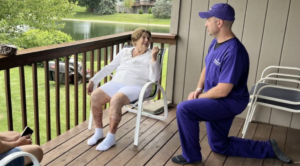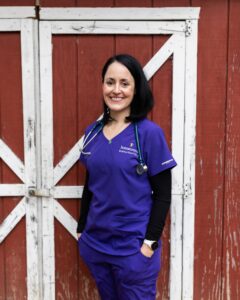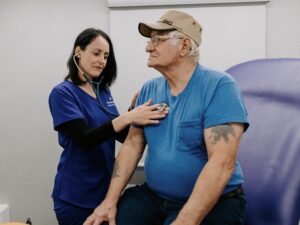PAs Anderson and Kent Make Career Pivots to Address Care Gaps in Rural Areas
“What we’re providing is life changing for a lot of these patients”
November 16, 2023
By Dave Andrews

Throughout his 20-year career serving in the U.S. Army as a medic, PA, and medical director, Jeff Anderson, PA-C, developed a propensity for taking on challenges and finding solutions. Although his military service is now complete, his mission remains much the same: Help as many patients as possible, especially those who live in remote areas with limited access to care.
Having grown up in a rural area of Allendale, Michigan, Anderson is all too familiar with the issues rural communities face when finding healthcare, and he wanted to help bridge that gap. So, a little more than a year ago, Anderson made the switch from serving as a PA in the military to practicing medicine as a civilian.
“I know what a struggle it is for people in rural communities to get quality care,” said Anderson, who now works for Homeward Health, a healthcare company serving rural areas throughout Michigan and Minnesota. “There’s a much higher mortality rate if you live in a rural area, regardless of your socioeconomic status.”
Indeed, the Centers for Disease Control and Prevention estimates those who live in rural areas have a 20% higher mortality rate than those who live in more urban regions. And with more than 60 million people living in rural America, Anderson says there is a significant opportunity for providers—and especially PAs—to make a difference.

“I’d practiced many different kinds of medicine in the Army and I worked alongside a lot of talented PAs who inspired me with how easily they adapted to various roles,” Anderson said. “Seeing their ability to work autonomously to help save lives, often during intense situations and with limited resources, was a valuable learning opportunity for me.”
The provider teams of Homeward that Anderson collaborates with include medical assistants, nurse practitioners, physicians, and other PAs, all delivering care through a variety of channels in order to reach patients across an expansive region. Homeward offers care through video and telehealth, mobile clinics and in-home visits, as well as traditional in-person clinic visits.
Anderson says that because there are so many different ways he can deliver care, he never has a “typical day” at work. “Any given day is likely to be different from the last,” he said. “And every one of the providers is enabled to practice at the top of their licensure because the demand for care in rural areas is so high.”
Many of Anderson’s patients are struggling with cardiovascular disease comorbidities including chronic hypertension, diabetes, and hyperlipidemia—issues that can often stem from infrequent preventative care screenings.

By giving rural residents a variety of options for receiving care, Anderson has witnessed the emotional—as well as physical—impact his team is making across the region.
Among his wide range of cases, one recent patient was particularly grateful for the level of care Anderson was able to provide: a woman in her mid-80s, recently widowed and living alone in her home approximately 40 miles from the nearest care facility. With limited and costly options for transportation, she was only able to get to her primary care provider once a year, at most.
“She told me she had just given up and wasn’t planning to receive any more healthcare because it was too difficult,” Anderson said. “When I told her we could come to her home and provide the care she needed, she broke down crying and told me that now she has hope.”
The ability to provide care across convenient locations, including local clinics and in-home, is a big draw for many rural patients. And a rapidly growing portion of patients are opting to connect with providers either virtually or by phone, as well.
Siobhan Kent, PA-C, one of Anderson’s colleagues at Homeward, cares for most of her patients through video and telehealth. After having worked several years in a clinic setting for her previous employer, Kent says she sees significant upside for remote healthcare, especially within rural communities.
“Unfortunately, people who live in rural areas often grow accustomed to not having certain amenities and services within reach,” Kent said. “So, for many of them, they’ll develop a habit of just ignoring seemingly minor problems, which over time can develop into very serious issues.”

Through the virtual and telehealth visits, Kent says she can connect with the patients more frequently and easily than with in-person visits, leading to improved patient outcomes. “Many of them have multiple needs that aren’t met, and they don’t even realize it,” Kent said. “Catching these conditions earlier, before they turn into something much more serious like a heart attack, is definitely key.”
Although most of her visits are virtual, Kent says she is still able to establish a strong rapport with her patients. The online format saves everyone time—especially those who live in distant locations—and allows her to dedicate more time to each patient.
“We don’t just ask about their medical conditions. We get to know more about them: their home environment, what’s going on in their lives and who they have to help support them—all of which can factor into their physical health,” Kent said.
Similar to Anderson, Kent made a career pivot to rural healthcare after working for several years in a different field. Now that she is making a direct impact on improving access to care for numerous patients, she knows she made the right decision.
“What we’re providing is life changing for a lot of these patients, many of whom would have no other options to access care,” Kent said. “I love knowing that I’m helping to address a critical need, and that gives me a lot of motivation each day.”
You May Also Like
PA Teresa Lowe Advocates for Culturally Competent Care for Alaska Natives
Barriers to Care: Four PAs Talk About Serving Rural Communities During the Pandemic
What Barriers Stand Between PAs and Rural Settings, MUAs, and HPSAs?
Thank you for reading AAPA’s News Central
You have 2 articles left this month. Create a free account to read more stories, or become a member for more access to exclusive benefits! Already have an account? Log in.




